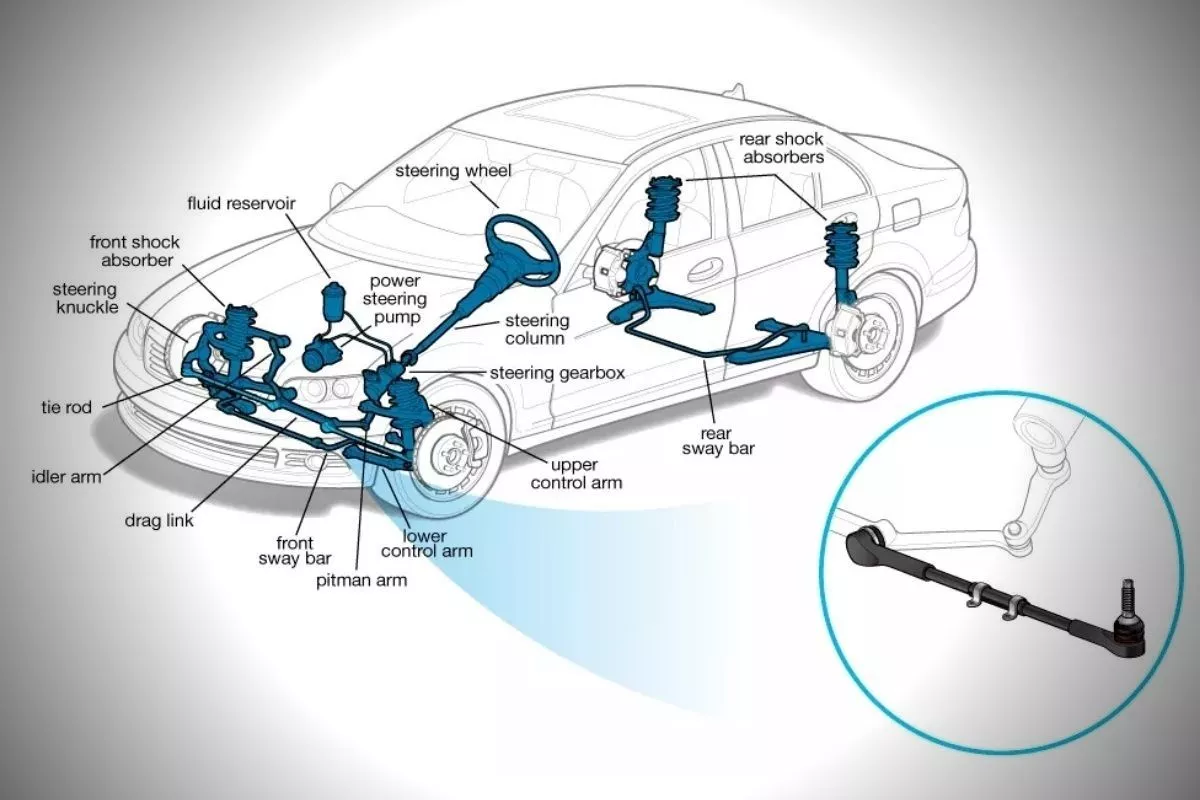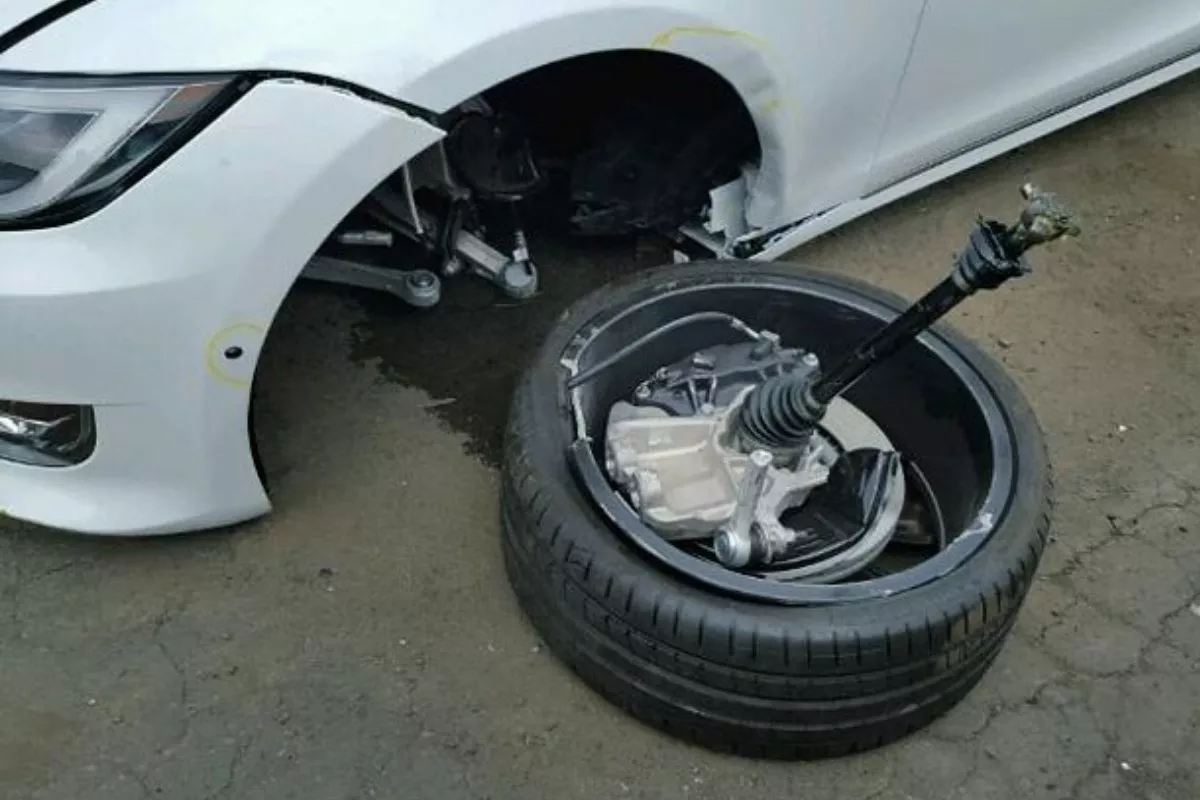If we went by the more general definition of what a tie rod is, then it’s a structure capable of holding tensile loads. In the automotive world, a tie rod is a component of a car’s steering mechanism and the suspension system. It enables steering as it connects both front wheels together.
That said, the automotive tie rod is similar to the general definition in that it has the capability to hold some degree of tension. This might come from the forces being transmitted from the tires themselves, and the mass of the vehicle.

The tie rod itself is the object encircled in blue
As such, the tie rod can go bad and can wear out. Driving with a bad tie rod is particularly dangerous because you cannot predict when it will cease to function completely.
This is dangerous because once it ceases to work, you’ll lose a great deal of steering control. A car without steering is nothing more than a motorized road-going missile.
So, how do you tell if a tie rod is bad or going bad?
How to tell if a tie rod is bad
Symptom #1: Uneven tire wear
One of the early signs of a deteriorated tie rod is uneven tire wear. It can even cause even more tire wear overall. This is because when it is functioning properly, the weight of the vehicle is perfectly balanced, and the tires have a relatively equal amount of contact on the road.
When the tie rods go bad, the tires’ alignment will be affected negatively too. To be more specific, uneven tire alignment can cause uneven tire wear.
>>> Related: 10 kinds of tire wear can indicate a car’s general condition

Example of uneven tire wear
Symptom #2: Clunking noises and vibrations when driving
Another sign of a bad tire rod is a vibrating or shaking steering wheel. Moreover, will you also hear clunking noises when performing low-speed maneuvers? This is caused by a loose tie rod whose joints have more movement.
Symptom #3: Lessened or complete loss of steering
The worst symptom of a bad tie rod is the loss of steering. Your steering wheel will feel looser than usual, and you’ll have to adjust it more than usual to control your vehicle. This symptom is particularly dangerous when driving at high speeds.
Do note though that many other things can cause steering problems. There might be something wrong with your power steering, your steering rod, etc. That said though, one of the most common causes of this symptom is a bad tie rod.
>>> Related: 7 Signs of a Bad Steering Wheel and How to Fix Them
Loose wheels when jacked up
While not a symptom per se, this is more of a test that will determine if something is really wrong with your car’s tie rods.
To perform this, simply jack up the front of your car, then try to move the wheel from side to side. If the tie rods have deteriorated, the tires will feel really loose. In most cases, you’ll also hear clicking noises when you move it around.
4 signs of a worn tie-rod end [Autodoc]
How driving with a bad tie rod can endanger your car and safety on the road
Effect 1: More damage to underchassis components
When it comes to a bad tie rod end that’s gone loose, its joints and links will allow dirt and grime in. These will eventually mix in with the lubricant that can increase friction. Moreover, it can even displace the said lubricant from the joint and/or links.
![A very rusty tie rod [Photo: Reddit User Vekin101] A picture of a very rusty tie rod](https://img.philkotse.com/temp/2024/07/27/rusty-tie-rod-reddituser-vekin101-bab5-9197.webp)
A rusty tie rod [Photo: Reddit User Vekin101]
The added friction due to the dirt and having less lubricant may cause more vibrations and noises. In the long run, this might also cause rust. And for those who don’t know, rust can spread. If it has spread enough, it will have negative consequences on the overall structural rigidity of the car.
>>> Related:
Effect 2: Less agility
As we’ve established, a bad tie rod can result in loose, unresponsive steering. So, no matter how quick your reaction time is, a car with a bad tie rod end isn’t as maneuverable and agile as a car in tip-top shape. This of course means that you’ll have less ability to evade potential accidents.
Effect 3: Less traction
Bad tie rods can cause uneven tire wear. Uneven tires can result in uneven weight distribution, uneven tire contact points, and overall less traction.
Less traction can increase your chances to get involved in accidents, and uneven weight distribution can cause handling issues. Driving for a long time on unevenly worn tires might even affect your car’s chassis and suspension system.
Effect 4: Cost
If you continue to drive your car even if you know that its tire rod has gone bad, it will cost you more in the long run. You’ll have to replace more tires and you’ll have to address the rust and busted-up joints and linkages.
Worst of all, you might have to cough up even more dough when you eventually crash your car.

A Tesla with its totally broken tie rod
In the worst case, the tie rod that’s going bad can snap. This will cause one or both tires to flop to the side, so you’ll have no steering control at all. If you’re lucky, you might be able to stop safely.
Then again, a car with a tie rod that snapped in two is totally undrivable, thus leaving you stranded.
How much does it cost to replace a broken tie rod?
The cost of replacing a bad tie rod can vary depending on where you are in the Philippines, the mechanic, and the brand and make of your car.
If we had to give an estimate, a replacement aftermarket tie rod for a popular SUV, MPV, or pickup truck will cost you somewhere around Php 1,700 above. Tie rods for smaller cars are cheaper.

If you're only replacing the tie rod ends, then it might be an easier, cheaper fix
To conclude, have your car’s under chassis checked periodically by a competent mechanic. Moreover, experiencing one of two of the symptoms of a bad tie rod while driving should immediately prompt you to acquire a replacement.
Doing so will avoid more costs, and more importantly, will ensure your safety on the road.
For more useful maintenance guides, car reviews, and the latest automotive industry news, keep it here on Philkotse.com.
Driving with a bad tie rod: FAQs
1. Can you drive a car with bad tie rods?
Answer: Yes you can. But we do not recommend it. That’s because the more you drive a car with a bad tie rod, the more it’ll get worse.
2. What do I do if my tie rod snaps while driving?
Answer: When your tie rod breaks while driving, you might lose control. If you do, keep calm, and lay off the accelerator. Next, turn on your hazards, and try to stop on a safe spot on the road. Once you’ve done those, call a tow truck.
3. Where can I buy a replacement tie rod?
Answer: We recommend buying a replacement tie rod from your car’s dealership. If that isn’t possible, replacement tie rods are available in authorized car parts dealers, and on local e-commerce websites.
4. Can I replace my bad tie rod by myself?
Answer: With the right tools, you can replace a tie rod by yourself. You’ll need jack stands though. Just to be sure, we recommend having a mechanic do this.
5. Can I still use tires with uneven wear?
Answer: We do not recommend using tires with uneven wear because they will have uneven contact patches. You’ll also have less friction on the tire with the most wear. This can damage other parts of your vehicle in the long run.
>>> Related: Tire Rods: 3 symptoms that it is going bad and how to replace it
Recent posts
- body lift vs suspension lift pros cons Mar 10, 2022
- how to unlock a steering wheel without key Mar 10, 2022
- 6 common symtoms of a car's suspension system problems Oct 22, 2020
- Suspension modifications for off-road goodness in the Philippines Feb 17, 2021
- Suspension modifications for city driving & heavy duty in the Philippines Feb 17, 2021












